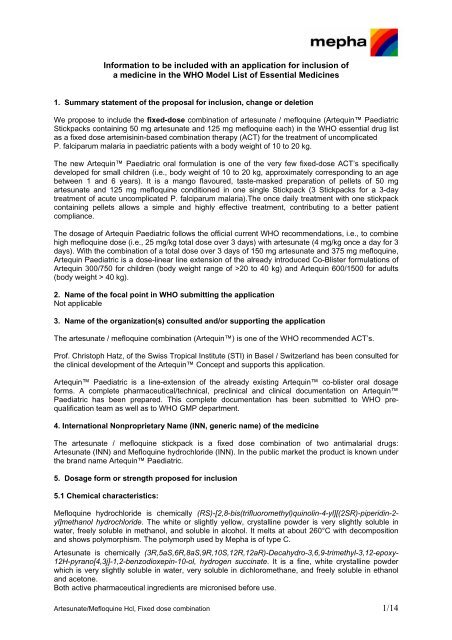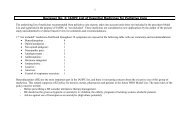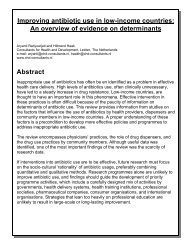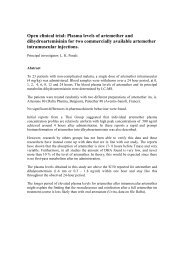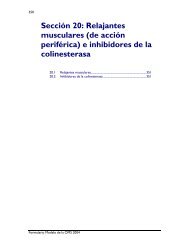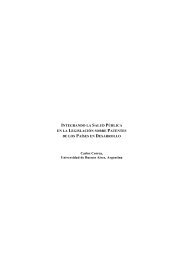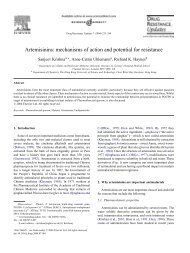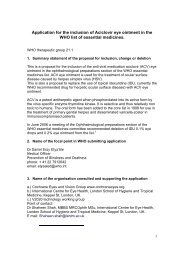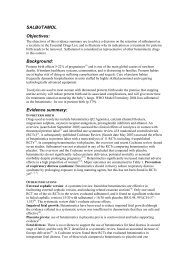Artesunate + mefloquine fixed-dose combination
Artesunate + mefloquine fixed-dose combination
Artesunate + mefloquine fixed-dose combination
Create successful ePaper yourself
Turn your PDF publications into a flip-book with our unique Google optimized e-Paper software.
Information to be included with an application for inclusion of<br />
a medicine in the WHO Model List of Essential Medicines<br />
1. Summary statement of the proposal for inclusion, change or deletion<br />
We propose to include the <strong>fixed</strong>-<strong>dose</strong> <strong>combination</strong> of artesunate / <strong>mefloquine</strong> (Artequin Paediatric<br />
Stickpacks containing 50 mg artesunate and 125 mg <strong>mefloquine</strong> each) in the WHO essential drug list<br />
as a <strong>fixed</strong> <strong>dose</strong> artemisinin-based <strong>combination</strong> therapy (ACT) for the treatment of uncomplicated<br />
P. falciparum malaria in paediatric patients with a body weight of 10 to 20 kg.<br />
The new Artequin Paediatric oral formulation is one of the very few <strong>fixed</strong>-<strong>dose</strong> ACT’s specifically<br />
developed for small children (i.e., body weight of 10 to 20 kg, approximately corresponding to an age<br />
between 1 and 6 years). It is a mango flavoured, taste-masked preparation of pellets of 50 mg<br />
artesunate and 125 mg <strong>mefloquine</strong> conditioned in one single Stickpack (3 Stickpacks for a 3-day<br />
treatment of acute uncomplicated P. falciparum malaria).The once daily treatment with one stickpack<br />
containing pellets allows a simple and highly effective treatment, contributing to a better patient<br />
compliance.<br />
The dosage of Artequin Paediatric follows the official current WHO recommendations, i.e., to combine<br />
high <strong>mefloquine</strong> <strong>dose</strong> (i.e., 25 mg/kg total <strong>dose</strong> over 3 days) with artesunate (4 mg/kg once a day for 3<br />
days). With the <strong>combination</strong> of a total <strong>dose</strong> over 3 days of 150 mg artesunate and 375 mg <strong>mefloquine</strong>,<br />
Artequin Paediatric is a <strong>dose</strong>-linear line extension of the already introduced Co-Blister formulations of<br />
Artequin 300/750 for children (body weight range of >20 to 40 kg) and Artequin 600/1500 for adults<br />
(body weight > 40 kg).<br />
2. Name of the focal point in WHO submitting the application<br />
Not applicable<br />
3. Name of the organization(s) consulted and/or supporting the application<br />
The artesunate / <strong>mefloquine</strong> <strong>combination</strong> (Artequin) is one of the WHO recommended ACT’s.<br />
Prof. Christoph Hatz, of the Swiss Tropical Institute (STI) in Basel / Switzerland has been consulted for<br />
the clinical development of the Artequin Concept and supports this application.<br />
Artequin Paediatric is a line-extension of the already existing Artequin co-blister oral dosage<br />
forms. A complete pharmaceutical/technical, preclinical and clinical documentation on Artequin<br />
Paediatric has been prepared. This complete documentation has been submitted to WHO prequalification<br />
team as well as to WHO GMP department.<br />
4. International Nonproprietary Name (INN, generic name) of the medicine<br />
The artesunate / <strong>mefloquine</strong> stickpack is a <strong>fixed</strong> <strong>dose</strong> <strong>combination</strong> of two antimalarial drugs:<br />
<strong>Artesunate</strong> (INN) and Mefloquine hydrochloride (INN). In the public market the product is known under<br />
the brand name Artequin Paediatric.<br />
5. Dosage form or strength proposed for inclusion<br />
5.1 Chemical characteristics:<br />
Mefloquine hydrochloride is chemically (RS)-[2,8-bis(trifluoromethyl)quinolin-4-yl][(2SR)-piperidin-2yl]methanol<br />
hydrochloride. The white or slightly yellow, crystalline powder is very slightly soluble in<br />
water, freely soluble in methanol, and soluble in alcohol. It melts at about 260°C with decomposition<br />
and shows polymorphism. The polymorph used by Mepha is of type C.<br />
<strong>Artesunate</strong> is chemically (3R,5aS,6R,8aS,9R,10S,12R,12aR)-Decahydro-3,6,9-trimethyl-3,12-epoxy-<br />
12H-pyrano[4,3j]-1,2-benzodioxepin-10-ol, hydrogen succinate. It is a fine, white crystalline powder<br />
which is very slightly soluble in water, very soluble in dichloromethane, and freely soluble in ethanol<br />
and acetone.<br />
Both active pharmaceutical ingredients are micronised before use.<br />
<strong>Artesunate</strong>/Mefloquine Hcl, Fixed <strong>dose</strong> <strong>combination</strong> 1/14
5.2 The formulation proposed for inclusion:<br />
The dosage form is constituted of pellets and a powder mixture filled in stickpacks. Each stickpack<br />
contains 50 mg <strong>Artesunate</strong> and 125 mg Mefloquine (corresponding to 137 mg Mefloquine<br />
hydrochloride) as drug substances.<br />
<strong>Artesunate</strong> plus Mefloquine is one of the three WHO-recommended ACTs to treat uncomplicated P.<br />
falciparum malaria.<br />
The <strong>Artesunate</strong>/ Mefloquine stickpack is an innovative <strong>fixed</strong>-<strong>dose</strong> ACT, especially developed for small<br />
children (10-20 kg). This <strong>fixed</strong>-<strong>dose</strong> <strong>combination</strong> was developed to ensure that patients take both<br />
drugs together in the right <strong>dose</strong>, with a particular attention paid to paediatric needs:<br />
- no water is needed to apply the pellets<br />
- the dosing scheme is easy and simple: 1 <strong>fixed</strong> <strong>dose</strong> daily for 3 days<br />
- the drug is easy to swallow, with a pleasant taste of mango<br />
5.3 Stability of the formulation<br />
Currently, three scale batches of <strong>Artesunate</strong> 50 mg / Mefloquine 125 mg Stickpacks are subject to a<br />
full stability programme including accelerated testing at 40°C / 75% RH.<br />
Based on the stability data obtained over a period of up to 12 months and the supportive date of the<br />
development batches a provisional shelf-life of 18 months can be presumed for the preparation<br />
<strong>Artesunate</strong> 50 mg / Mefloquine 125 mg stickpacks when it is stored below 25°C.<br />
Three production scale batches will be subject to a full stability programme.<br />
The stability studies on all mentioned batches will be continued up to the proposed end of shelf-life of<br />
36 months.<br />
6. International availability –sources, if possible manufacturers<br />
6.1 Sources of the active ingredients:<br />
Mefloquine HCl is manufactured by:<br />
CILAG AG<br />
Hochstr. 201<br />
CH-8205<br />
Switzerland<br />
<strong>Artesunate</strong> is manufactured by<br />
IPCA Laboratories Ltd.<br />
P.O Sejavta<br />
Dist. Ratlam<br />
Pin: 457 002<br />
India<br />
Or alternatively by<br />
Cambrex Profarmaco Landen<br />
Industriepark Roosvelt 2, B6<br />
3400 Landen<br />
Belgium<br />
<strong>Artesunate</strong>/Mefloquine Hcl, Fixed <strong>dose</strong> <strong>combination</strong> 2/14
6.2 Manufacturer of the finished product:<br />
The <strong>fixed</strong> <strong>dose</strong> <strong>combination</strong> of <strong>Artesunate</strong>/ Mefloquine HCl is manufactured by Mepha Ltd. in its<br />
manufacturing plant:<br />
Dornacherstrasse 114<br />
4147 Aesch<br />
Switzerland<br />
The manufacturer is certified as GMP compliant by its local authorities.<br />
A WHO inspection was also carried out from 25 to 27 April 2005 and the manufacturer was compliant<br />
with the principles and guidelines of WHO Good Manufacturing Practices.<br />
7. Whether listing is requested as an individual medicine or as an example of a therapeutic<br />
group<br />
<strong>Artesunate</strong> / Mefloquine <strong>fixed</strong>-<strong>dose</strong> <strong>combination</strong> (Artequin Paediatric Stickpacks containing 50 mg<br />
artesunate and 125 mg <strong>mefloquine</strong> each) should be listed in the WHO essential drug list within the<br />
pharmacotherapeutic group “antimalarial medicines for curative treatment”.<br />
8. Information supporting the public health relevance (epidemiological information on disease<br />
burden, assessment of current use, target population)<br />
Malaria is the most important of all tropical diseases and despite considerable efforts to eradicate or<br />
control the disease, malaria continues to be a major cause of human morbidity and mortality in the<br />
tropics, particularly in Africa and South-East Asia. Worldwide prevalence of the disease is estimated to<br />
be in the order of 300-500 million clinical cases each year and more than 90% of all malaria cases are<br />
in sub-Saharan Africa.<br />
In fact, out of more than 1 million deaths due to malaria in endemic regions each year, more than 80%<br />
occur in Africa south of the Sahara and over 75% occur in African children under 5 years infected with<br />
Plasmodium falciparum. About 1 in 5 (approx. 18%) of all childhood deaths in African is due to malaria<br />
resulting in one child’s death due to malaria every 30 seconds. In addition, an even greater proportion<br />
of child deaths is indirectly related to malaria: malaria infections contribute to the development of<br />
severe anaemia and make young children more susceptible to severe outcomes of common illnesses<br />
such as diarrhoea and respiratory diseases.<br />
Treatment of Plasmodium falciparum malaria in Africa is increasingly difficult. Resistance to cheap<br />
efficient antimalarial drugs poses an increasing threat.This is especially worrying in West Africa, where<br />
many health services depend on chloroquine as the first-line treatment of uncomplicated malaria,<br />
despite chloroquine resistance becoming more common.<br />
WHO, on the advice of international experts, recommends the introduction of <strong>combination</strong>s of drugs to<br />
replace single drugs in the treatment of Plasmodium falciparum malaria. WHO recommends in<br />
particular the use of drug <strong>combination</strong>s containing the peroxidic antimalarial artemisinin (derived from<br />
the herb Artemisia annua) and its derivatives such as artesunate, i.e., artemisinin-based <strong>combination</strong><br />
therapies (ACT), which provide an immediate solution to the problem of drug resistance.<br />
These recommendations led to the selection of two highly potent ACT partner drugs, namely<br />
artesunate and <strong>mefloquine</strong>, as active ingredients of Artequin Co-blister tablets as well as the <strong>fixed</strong><strong>dose</strong><br />
<strong>combination</strong> (FDC) of Artequin Paediatric Stickpacks.<br />
9. Treatment details (dosage regimen, duration; reference to existing WHO and other clinical<br />
guidelines; need for special diagnostic or treatment facilities and skills)<br />
Posology and method of administration:<br />
Patients with a body weight between 10 and 20 kg<br />
A treatment course with Artequin Paediatric comprises 3 stickpacks, each containing 50 mg<br />
artesunate and 125 mg <strong>mefloquine</strong>. One stickpack is to be taken once daily for 3 consecutive days.<br />
<strong>Artesunate</strong>/Mefloquine Hcl, Fixed <strong>dose</strong> <strong>combination</strong> 3/14
The first stickpack is given at the time of initial diagnosis, followed by a second stickpack 24 hours<br />
thereafter and a third (last) stickpack 48 hours after the initial one.<br />
If any Artequin Paediatric daily <strong>dose</strong> (1 stickpack) is missed, the patient should be advised to take the<br />
missed <strong>dose</strong> as soon as it is realised that it has been forgotten. Then the next <strong>dose</strong> should be taken<br />
after a further 24 hour interval.<br />
Patients who vomit within 1 hour after administration of any Artequin Paediatric daily <strong>dose</strong> (1<br />
stickpack) should be given a replacement (full) <strong>dose</strong>. In this case, the prescription of another Artequin<br />
Paediatric box should be considered. Parts of this new box may be used to ensure that the patient will<br />
complete a 3-day full treatment course with Artequin Paediatric.<br />
The <strong>combination</strong> of artesunate and <strong>mefloquine</strong> can also be used to treat malaria caused by mixed<br />
Plasmodium pathogens. Following treatment with Artequin of malaria caused by a mixed infection with<br />
P. vivax, relapse prophylaxis with an 8-aminoquinoline derivative (e.g. primaquine) should be<br />
considered to eliminate hepatic forms of the parasite.<br />
Patients with more than 20 kg body weight<br />
For these patients higher Artequin dosage regimens are recommended depending on the body weight.<br />
Patients with less than 10 kg body weight<br />
Artequin Paediatric is not recommended for use in patients who have less than 10 kg body weight.<br />
Method of administration<br />
Just before administration, the Artequin Paediatric stickpack should be opened (following the preprinted<br />
doted line on the top of the stickpack) and its content (pellets) should be administered directly<br />
on to the patient’s tongue.<br />
In case of direct mouth administration difficulties, the stickpack content can be put on a spoon and<br />
administered with a small amount of liquid.<br />
The mouth should thereafter be rinsed with some liquid, e.g. with milk or water, and remaining pellets<br />
swallowed. Patients should be encouraged to resume normal food intake as soon as food can be<br />
tolerated.<br />
For further information please refer to the Summary of the Product Characteristics enclosed in section<br />
15.<br />
10. Summary of comparative effectiveness in a variety of clinical settings:<br />
The pharmacokinetic and clinical efficacy of the <strong>Artesunate</strong> / <strong>mefloquine</strong> <strong>combination</strong> is fully presented<br />
in the registration file Artequin Paediatric which has been submitted to WHO pre-qualification team as<br />
well as to WHO GMP department.<br />
An identification of the clinical evidence and a summary of available data are presented in details in<br />
section 2.5.2 Overview of Biopharmaceutics and section 2.5.4 Overview of Efficacy of the Artequin<br />
Paediatric Stickpack Clinical Overview Document (module 2.5 of the registration file) as well as in<br />
the Artequin Paediatric Stickpack Clinical Summary Document (module 2.7 of the registration file).<br />
Both documents are attached to this application.<br />
Conclusions on efficacy of the artesunate/<strong>mefloquine</strong> <strong>combination</strong>:<br />
A considerable number of clinical studies have evaluated and confirmed the excellent efficacy of the<br />
artesunate-<strong>mefloquine</strong> <strong>combination</strong> regimen in uncomplicated malaria. These promising findings led<br />
Mepha to the development of the Artequin concept with pre-packed <strong>combination</strong>-blisters of the already<br />
marketed artesunate and <strong>mefloquine</strong> tablets for one course of a three-day therapy.<br />
The two randomized, double blind, parallel group, comparative, phase III studies investigating three<br />
different solid oral dosage strengths of Artequin (600/1500, 600/750 and 300/750) have proven in<br />
adults and children with uncomplicated malaria the high efficacy and adequate tolerability of this<br />
<strong>combination</strong> product.<br />
The series of post-marketing Artequin studies conducted in different malaria endemic regions of Africa<br />
confirm the high efficacy of the Artequin therapy concept also in an extended therapeutic range for<br />
<strong>Artesunate</strong>/Mefloquine Hcl, Fixed <strong>dose</strong> <strong>combination</strong> 4/14
children below a body-weight of 30 kg and for adults of more than 55 kg. The overall experience out of<br />
these Artequin studies strengthened the decision to continue the clinical development plan of Artequin<br />
with the final goal to provide a <strong>fixed</strong>-<strong>dose</strong> <strong>combination</strong> of artesunate/<strong>mefloquine</strong> based on a pellet<br />
formulation for both active substances, and to further extend the <strong>dose</strong> range to small children not able<br />
to swallow tablets.<br />
Several pharmacokinetic and in-vitro investigations build the basis for a successful <strong>dose</strong>-linear<br />
downscaling of the high <strong>mefloquine</strong> <strong>dose</strong> formulation of Artequin Co-blister to the first real galenical<br />
formulation for small children, namely Artequin Paediatric Stickpack. Following findings and<br />
conclusions out of these investigations are of importance:<br />
Bioequivalence demonstrated between the <strong>mefloquine</strong> tablet formulation of Artequin and the<br />
reference product Lariam allows to conclude on similarity between the two formulations<br />
regarding efficacy and safety.<br />
Lack of clinically relevant pharmacological interaction between the two active ingredients<br />
artesunate and <strong>mefloquine</strong> allows to take for reference the huge clinical experience with the<br />
single substances in the <strong>dose</strong> designed for the FDC of Artequin Paediatric Stickpacks (daily<br />
<strong>dose</strong>s of artesunate 50 mg and <strong>mefloquine</strong> 125 mg). As a consequence, PK characteristics of<br />
both artesunate and <strong>mefloquine</strong> are supposed to be basically identical when administered<br />
alone or in <strong>combination</strong>. Therefore, the special clinical properties of the two antimalarials (fast<br />
but short acting artesunate – long lasting additive and protective effect of <strong>mefloquine</strong>) which<br />
are important for the ACT concept as used in the FDC Artequin Paediatric, are fully<br />
maintained in the <strong>combination</strong>.<br />
The proven linear <strong>dose</strong> dependency and proportionality of the pharmacokinetics of artesunate<br />
in the <strong>dose</strong> range of 50 to 200 mg and the known <strong>dose</strong>-linearity of <strong>mefloquine</strong> up to a <strong>dose</strong> of<br />
1000 mg is an important prerequisite for down-scaling the artesunate/<strong>mefloquine</strong> <strong>combination</strong><br />
from the already existing dosage forms of Artequin 600/1500 and 300/750 in <strong>dose</strong>-linear<br />
proportionality to Artequin Paediatric, i.e., to further halve the <strong>dose</strong> to the total therapeutic<br />
<strong>dose</strong> of 150 mg artesunate and 375 mg <strong>mefloquine</strong>.<br />
Similarity between the in-vitro dissolution profiles of the artesunate as well as <strong>mefloquine</strong><br />
pellets in Artequin Paediatric and of the artesunate and <strong>mefloquine</strong> tablets in Artequin Coblister<br />
demonstrate pharmaceutical equivalence of the two formulations. As a consequence,<br />
similar release of the active ingredients in the gastrointestinal tract, and thus, similar<br />
absorption patterns can be expected resulting in similar pharmacokinetic and<br />
pharmacodynamic characteristics of both the Artequin Co-blister dosage forms and the FDC<br />
of Artequin Paediatric.<br />
Study AM-P 001-2005, carried out on children with acute uncomplicated P. falciparum malaria in<br />
Gabon provides a formal prove that the galenical <strong>dose</strong>-linearity realised in the dosage of Artequin<br />
Paediatric results in similar PK characteristics in children with a body weight of 10 to 20 kg as reached<br />
with the double <strong>dose</strong>, i.e., with Artequin 300/750 given to children with body-weight >20 to 40 kg. As<br />
consequentially expected, the study outcome showed an appropriate efficacy of Artequin Paediatric<br />
Stickpacks and Artequin 300/750 co-blisters as measured by 28-day and 14-day cure rates of 100%<br />
with rapid parasite and fever clearance, in their respective target population. These high healing rates<br />
were in line with those demonstrated in the other clinical studies (all post-marketing phase IV as well<br />
as the randomized, comparative phase III studies). Irrespective of the <strong>dose</strong> administered with regard<br />
of the <strong>mefloquine</strong> partner drug of Artequin, there were never issues regarding the efficacy of the<br />
therapy over the whole <strong>dose</strong>-range investigated.<br />
Acceptability of intake of study medication is of great importance in pediatric patient populations as a<br />
prerequisite for compliance. Acceptability in the total paediatric study group kept constant above 80%<br />
over all three days of therapy which also demonstrate that no negative experience was linked to the<br />
drug administration, neither with tablets from Artequin 300/750 nor with the pellet formulation of<br />
Artequin Paediatric.<br />
11. Summary of comparative evidence on safety<br />
The safety of the <strong>Artesunate</strong> / <strong>mefloquine</strong> <strong>combination</strong> is fully presented in the registration file Artequin<br />
Paediatric which has been submitted to WHO pre-qualification team as well as to WHO GMP<br />
department.<br />
<strong>Artesunate</strong>/Mefloquine Hcl, Fixed <strong>dose</strong> <strong>combination</strong> 5/14
A description of adverse effects/reactions and a summary of available data are presented in details in<br />
section 2.5.5 Overview of Safety and section 2.5.6 benefits and Risks conclusions of the Artequin<br />
Paediatric Stickpack Clinical Overview Document (module 2.5 of the registration file) as well as in<br />
the Artequin Paediatric Stickpack Clinical Summary Document (module 2.7 of the registration file).<br />
Both documents are attached to this application.<br />
Conclusions on safety of the artesunate/<strong>mefloquine</strong> <strong>combination</strong>:<br />
Overall, a reasonable safety profile has been reported in clinical studies with artesunate and<br />
<strong>mefloquine</strong> <strong>combination</strong> regimens. The relationship to study medication is rarely defined with certainty<br />
since similar symptoms as reported also rely to the malaria disease itself. For instance, the most<br />
commonly reported adverse effects were gastrointestinal disorders like abdominal pain, nausea,<br />
vomiting and diarrhoea, all of which are characteristic of acute malaria. Reported nervous system<br />
disorders like headache, dizziness and insomnia are, on the other hand, well known <strong>mefloquine</strong>related<br />
side effects, and therefore, not unexpected in the <strong>combination</strong> therapy with<br />
artesunate/<strong>mefloquine</strong>. The likelihood of underreporting of AEs in small children has previously been<br />
discussed and should be taken into consideration while discussing incidences of AEs.<br />
The safety observations in the set of clinical studies with Artequin were of particular interest, since<br />
tolerability of the regimen is a crucial determinant for compliance. The overall safety profile of Artequin<br />
was adequate and clinically acceptable irrespective of patient age and reflected the well-known<br />
profiles of both drugs when used as monotherapy. The evaluation of the safety data out of the postmarketing<br />
Artequin studies with special focus on the paediatric population revealed no <strong>dose</strong>dependency<br />
of the incidence of AEs within the group of small children with a BW between 10 to 20 kg,<br />
i.e., the target population for Artequin Paediatric. Thus, small children apparently tolerate the high<br />
<strong>dose</strong> Artequin therapy (as defined by the mean total <strong>mefloquine</strong> <strong>dose</strong> of 25 mg/kg) equally well, as<br />
demonstrated by the low incidence of gastrointestinal and neurological/psychiatric symptoms. Neither<br />
new clinically significant adverse reactions nor severe AEs have been observed with Artequin in the<br />
whole set of post-marketing studies.<br />
The good tolerability of Artequin Paediatric in small children with acute uncomplicated P falciparum<br />
malaria was confirmed in Study AM-P 001-2005. Most of the observed changes in laboratory tests and<br />
vital signs were likely to reflect the recovery from the malarial disease rather than safety problems<br />
related to the study treatment. Many reported signs and symptoms were likewise due to intercurrent<br />
metazoan parasite infections, a situation not to be neglected in malaria endemic regions. As in the<br />
other Artequin studies described before, no severe nor serious Adverse Events related to the study<br />
medications have been reported in Study AM-P 001-2005.<br />
The advantageous safety profile of Artequin in the whole paediatric population investigated has to be<br />
highlighted considering the fact that both study medications, i.e., Artequin 300/750 and Artequin<br />
Paediatric, contain the higher mean total <strong>mefloquine</strong> dosage of 25 mg/kg as currently recommended<br />
by the WHO for both Asia and Africa.<br />
Estimate of total patient exposure to Artequin Paediatric to date and Post-marketing<br />
Pharmacovigilance:<br />
Since its first launch in West African countries in May 2006, a total number of 343’000 children with a<br />
body weight of 10 to 20 kg have been treated with Artequin Paediatric. This number is based on the<br />
number of packs sold, i.e. one pack represents one full treatment.<br />
Continuous overall pharmacovigilance evaluation of the Artequin product range during the postauthorisation<br />
period is conducted. A Periodic Safety Update Report (PSUR) on Artequin / Artequin<br />
Paediatric covering the period 2000 to 31 July 2006 including data on worldwide marketing<br />
authorization status, exposure data, and adverse drug reaction on the artesunate-<strong>mefloquine</strong><br />
<strong>combination</strong> formulations registered by Mepha Ltd and evaluating the benefit-risk profile has been<br />
generated and concluded on the following points:<br />
<strong>Artesunate</strong>/Mefloquine Hcl, Fixed <strong>dose</strong> <strong>combination</strong> 6/14
• It was estimated that exposure to the different Artequin dosage strengths during the PSUR<br />
period corresponded to at least a total of 1’716’600 patients.<br />
• 3 serious cases reports of adverse drug reactions were reported during the period covered by<br />
this PSUR, 1 was listed and 2 other one were unlisted but considered not related to the drug<br />
intake<br />
• During the PSUR period, there were no regulatory authority’s or MAH’s actions taken for<br />
safety reason.<br />
• It was concluded that the general benefit/risk ratio on Artequin / Artequin Paediatric<br />
showed a positive profile and the registration should be maintained.<br />
12. Summary of available data on comparative cost and cost-effectiveness within the<br />
pharmacological class or therapeutic group<br />
12.1. Range of costs of the proposed medicine<br />
One full treatment with one pack of Artequin Paediatric containing 3 stickpacks is priced for<br />
approximatively USD 7.--. This public selling price might be different from country to country,<br />
depending on the importation and customs duties as well as margins of wholesalers and pharmacists.<br />
12.2. Comparative cost-effectiveness presented as range of cost per routine outcome (e.g. cost<br />
per case, cost per cure, cost per month of treatment, cost per case prevented, cost per clinical<br />
event prevented, or, if possible and relevant, cost per quality-adjusted life year gained)<br />
A direct comparison with other antimalarials for small children is not possible as there are no other<br />
comparable drugs available, i.e. <strong>fixed</strong>-<strong>dose</strong> ACT’s for small children. The comparison with e.g. Co-<br />
Artesiane Suspension (artemether+lumefantrine dry powder) shows that in most countries of West<br />
Africa, this product is sold at a higher price. The same is true for the private market selling price of<br />
Coartem tablets which have to be crushed for the application in small children.<br />
13. Summary of regulatory status of the medicine (in country of origin, and preferably in other<br />
countries as well)<br />
Please be informed that <strong>Artesunate</strong>/Mefloquine stickpack (i.e Artequin Paediatric) is not sold in its<br />
country of origin, Switzerland, as malaria is not endemic in this country.<br />
Following endemic countries have granted local Marketing Authorisation: Benin, Burkina Faso,<br />
Cameroon, Chad, Congo (Brazzaville), Gabon, Guinea, Ivory Coast, Niger, Nigeria, Senegal and<br />
Togo.<br />
Registration procedures are ongoing in a certain number of other African countries: Ethiopia, Kenya,<br />
Mali, Mauritius, Sudan, Tanzania and Uganda.<br />
In parallel, on December 22, 2006 Mepha Ltd. submitted the <strong>fixed</strong> <strong>dose</strong> <strong>combination</strong> dossier to the<br />
World Health Organisation, as part of the pre-qualification registration program concerning Artemisinin<br />
based antimalarial products.<br />
The Dossier is under examination by the WHO assessors.<br />
14. Availability of pharmacopoieal standards (British Pharmacopoeia, International<br />
Pharmacopoiea, United States Pharmacopoeia)<br />
The drug substances used in the formulation are Mefloquine hydrochloride and <strong>Artesunate</strong> which are<br />
antimalarial drug substances. <strong>Artesunate</strong> is described in the International Pharmacopeia and<br />
Mefloquine hydrochloride is described in the European Pharmacopeia<br />
<strong>Artesunate</strong>/Mefloquine Hcl, Fixed <strong>dose</strong> <strong>combination</strong> 7/14
15. Proposed (new/adapted) text for the WHO Model Formulary<br />
1. Name of the Medicinal Product<br />
Artequin Paediatric<br />
2. Qualitative and Quantitative Composition<br />
Each packing of Artequin Paediatric is composed of:<br />
3 stickpacks containing each 50 mg artesunate and 125 mg <strong>mefloquine</strong> base (in the form of 137.0 mg<br />
<strong>mefloquine</strong> hydrochloride).<br />
For excipients, see section 6.1.<br />
3. Pharmaceutical Form<br />
Stickpack of pellets and powder<br />
4. Clinical Particulars<br />
4.1 Therapeutic indications<br />
Artequin Paediatric is indicated for the oral treatment of non-complicated P. falciparum malaria<br />
occurring in endemic areas, in patients with a body weight between 10 and 20 kg.<br />
Artequin Paediatric can also be used in multi-drug resistant areas or areas where resistance is<br />
developing to current therapies for P. falciparum infection.<br />
4.2 Posology and method of administration<br />
Patients with a body weight between 10 and 20 kg<br />
A treatment course with Artequin Paediatric comprises 3 stickpacks, each containing 50 mg<br />
artesunate and 125 mg <strong>mefloquine</strong>. One stickpack is to be taken once daily for 3 consecutive days.<br />
The first stickpack is given at the time of initial diagnosis, followed by a second stickpack 24 hours<br />
thereafter and a third (last) stickpack 48 hours after the initial one.<br />
If any Artequin Paediatric daily <strong>dose</strong> (1 stickpack) is missed, the patient should be advised to take the<br />
missed <strong>dose</strong> as soon as it is realised that it has been forgotten. Then the next <strong>dose</strong> should be taken<br />
after a further 24 hour interval.<br />
Patients who vomit within 1 hour after administration of any Artequin Paediatric daily <strong>dose</strong> (1<br />
stickpack) should be given a replacement (full) <strong>dose</strong>. In this case, the prescription of another Artequin<br />
Paediatric box should be considered. Parts of this new box may be used to ensure that the patient will<br />
complete a 3-day full treatment course with Artequin Paediatric.<br />
The <strong>combination</strong> of artesunate and <strong>mefloquine</strong> can also be used to treat malaria caused by mixed<br />
Plasmodium pathogens. Following treatment with Artequin of malaria caused by a mixed infection with<br />
P. vivax, relapse prophylaxis with an 8-aminoquinoline derivative (e.g. primaquine) should be<br />
considered to eliminate hepatic forms of the parasite.<br />
Patients with more than 20 kg body weight<br />
For these patients higher Artequin dosage regimens are recommended depending on the body weight.<br />
Patients with less than 10 kg body weight<br />
Artequin Paediatric is not recommended for use in patients who have less than 10 kg body weight.<br />
<strong>Artesunate</strong>/Mefloquine Hcl, Fixed <strong>dose</strong> <strong>combination</strong> 8/14
Method of administration<br />
Just before administration, the Artequin Paediatric stickpack should be opened (following the preprinted<br />
doted line on the top of the stickpack) and its content (pellets) should be administered directly<br />
on to the patient’s tongue.<br />
In case of direct mouth administration difficulties, the stickpack content can be put on a spoon and<br />
administered with a small amount of liquid.<br />
The mouth should thereafter be rinsed with some liquid, e.g. with milk or water, and remaining pellets<br />
swallowed. Patients should be encouraged to resume normal food intake as soon as food can be<br />
tolerated.<br />
4.3 Contra-Indications<br />
Artequin Paediatric is contraindicated in patients with a known hypersensitivity to artesunate or<br />
<strong>mefloquine</strong>, to their chemically related compounds like other artemisinin derivatives, quinine, quinidine<br />
or chloroquine, or to any other ingredient of the stickpack content. Artequin Paediatric must not be<br />
used together with halofantrine.<br />
4.4 Special warnings and special precautions for use<br />
Artequin Paediatric is not recommended for the prophylaxis of malaria.<br />
In epileptics, <strong>mefloquine</strong> may increase the risk of seizures. In these patients Artequin Paediatric<br />
should therefore only be used if absolutely required by the medical condition.<br />
Halofantrine, which is known to cause QT interval prolongation, must not be administered<br />
concomitantly with or after a <strong>mefloquine</strong>-containing antimalarial agent like Artequin, because of the<br />
risk of a potentially fatal prolongation of the QT interval.<br />
Incidents of dizziness, disturbed sense of balance or neuropsychiatric reactions have been reported<br />
both during use and up to three weeks after the last <strong>dose</strong> of <strong>mefloquine</strong> due to its long half-life.<br />
Therefore, caution is also advised in patients receiving any dos-age regimen of Artequin when<br />
pursuing activities requiring full attention and fine-motor co-ordination for example driving vehicles and<br />
operating machinery.<br />
Artequin Paediatric is not recommended for use in patients who have less than 10 kg body weight.<br />
Higher Artequin dosage regimens are recommended for use in patients who have more than 20 kg<br />
body weight.<br />
4.5 Interaction with other medicinal products and other forms of interaction<br />
So far, there have been no reports of negative drug interactions with artesunate.<br />
Concomitant administration of <strong>mefloquine</strong> and related substances (e.g. quinine, quinidine and<br />
chloroquine) may produce electrocardiographic abnormalities and increase the risk of convulsions.<br />
Therefore, halofantrine, which is known to cause QT interval prolonga-tion, must not be administered<br />
concomitantly with or after<br />
Artequin for at least 3 weeks. In patients undergoing treatment with anticonvulsives such as valproic<br />
acid, carbamazepine, phenobarbital or phenytoin, <strong>mefloquine</strong> contained in Artequin may lower the<br />
plasma concentration of the anticonvulsive, resulting in seizures. In such cases, it may be required to<br />
adjust the dosage of the anticonvulsive (see also section 4.4).<br />
4.6 Pregnancy and lactation<br />
Pregnancy category C<br />
Clinical experience with artesunate or <strong>mefloquine</strong> used as monotherapy has not revealed any<br />
embryotoxic or teratogenic effects. However, as experience in pregnant patients is limited, Artequin<br />
should not be administered during pregnancy unless the treatment is considered life saving and the<br />
expected benefit justifies the potential risk for the foetus.<br />
Mefloquine passes in small quantities into breast milk, the effects of which are, however, unknown.<br />
Therefore, decision should be made whether to treat the mother with Artequin, taking into account the<br />
importance of the drug to the mother.<br />
<strong>Artesunate</strong>/Mefloquine Hcl, Fixed <strong>dose</strong> <strong>combination</strong> 9/14
4.7 Effects on ability to drive and use machines<br />
As outlined under section 4.4, possible side effects of <strong>mefloquine</strong> necessitate caution when driving<br />
and using machines during and up to three weeks after therapy with a <strong>mefloquine</strong> containing<br />
antimalarial agent like Artequin.<br />
4.8 Undesirable effects<br />
Adverse events experienced by patients taking antimalarial drugs often mirror the symptoms of an<br />
acute malaria infection. It may therefore not be possible to distinguish undesirable effects of Artequin<br />
Paediatric from the symptoms of the disease.<br />
The most common adverse experiences reported in clinical studies on patients treated with Artequin<br />
were:<br />
Gastrointestinal disorders<br />
Common*: abdominal pain, nausea, vomiting and diarrhoea<br />
Nervous system disorders<br />
Common*: headache, dizziness and insomnia<br />
General and metabolism disorders<br />
Common*: asthenia, anorexia and hypokalaemia<br />
* Common: 1 to 10%.<br />
Most of these adverse events were of mild to moderate severity and occurred with a similar frequency,<br />
when historically compared to the incidence rate of adverse events observed in patients receiving<br />
either drug as monotherapy.<br />
No other significant adverse effects have been observed in patients treated with Artequin. The<br />
following most common adverse events have been reported in the literature with the <strong>combination</strong> of<br />
artesunate and <strong>mefloquine</strong>: headache and allergic reactions including rash and pruritus. In rare cases<br />
mild and transient reduction in reticulocytes and neutrophil granulocytes, as well as transient increase<br />
in transaminases and total bilirubin have been described. Nevertheless, any other side effects that<br />
have been reported with either artesunate or <strong>mefloquine</strong> used as monotherapy could also occur with<br />
Artequin Paediatric.<br />
Undesirable effects also reported with artesunate monotherapy<br />
Clinical laboratory findings occasionally showed mild and transient reduction in reticulocytes and<br />
neutrophil granulocytes, especially the young forms, but there were no symptoms or signs of<br />
superimposed infections. In rare cases, transient increases in transaminases have been reported.<br />
Other undesirable effects reported with <strong>mefloquine</strong> monotherapy<br />
The most frequently reported adverse effects are nausea, vomiting, soft stools or diarrhoea and<br />
abdominal pain, dizziness or vertigo, disturbed sense of balance as well as neuropsychological<br />
adverse effects such as headache, somnolence and sleep disorders (sleeplessness, unusual dreams).<br />
Less frequent adverse effects reported with <strong>mefloquine</strong> monotherapy<br />
Central and peripheral nervous system: sensory and motor neuropathies (including paresthesia,<br />
tremor, ataxia), convulsions, agitation, visual disturbances, tinnitus and vestibular disturbances,<br />
anxiety, restlessness, depression, mood changes, panic attacks, forgetfulness, confusion,<br />
hallucinations, aggression as well as psychotic or paranoid reactions. There have been rare reports of<br />
suicidal ideations; however, a relationship to the administration of the drug could not be demonstrated.<br />
Cardiovascular system: circulatory disorders (hypotension, hypertension), skin reddening,<br />
unconsciousness, chest pain, tachycardia or palpitation, bradycardia, irregular heart-beat,<br />
extrasystoles and other transient conduction disturbances.<br />
<strong>Artesunate</strong>/Mefloquine Hcl, Fixed <strong>dose</strong> <strong>combination</strong> 10/14
Skin: skin rash, exanthema, erythema, urticaria, pruritus, oedema, hair loss.<br />
Locomotor system: muscle weakness and muscle cramps, myalgia, arthralgia.<br />
General symptoms: hearing impairment, dyspnoea, asthenia, malaise, fatigue, fever, sweating, chills,<br />
dyspepsia and loss of appetite.<br />
Laboratory abnormalities: transient increase of the transaminases, leucopenia or leucocytosis,<br />
thrombocytopenia.<br />
Isolated cases of erythema multiforme, Stevens-Johnson syndrome, AV-block and encephalopathy<br />
have been reported.<br />
Adverse reactions to <strong>mefloquine</strong> can occur or last for several weeks after the last <strong>dose</strong> on account of<br />
the long half-life.<br />
Neither in vitro nor in vivo studies suggest evidence of haemolysis in connection with a glucose-6phosphate<br />
dehydrogenase deficiency.<br />
4.9 Over<strong>dose</strong><br />
So far, no cases of over<strong>dose</strong> have been reported with artesunate. Overdosage with <strong>mefloquine</strong> may<br />
lead to increased occurrence of the <strong>mefloquine</strong>-related adverse effects.<br />
Recommended therapy in case of Artequin Paediatric overdosage consists of vomiting or gastric<br />
lavage and careful monitoring of the cardiac function (if possible by ECG) and of the neuropsychiatric<br />
status (for at least 24 hours).<br />
5. Pharmacological Properties<br />
5.1 Pharmacodynamic properties<br />
Pharmacotherapeutic group: Antimalarial<br />
ATC code: <strong>Artesunate</strong>: PO1B E03<br />
Mefloquine: PO1B C02<br />
Artequin Paediatric is a <strong>fixed</strong>-<strong>dose</strong> <strong>combination</strong> of two antimalarial drugs, artesunate and <strong>mefloquine</strong>.<br />
<strong>Artesunate</strong> is a water-soluble hemisuccinate ester of artemisinin, the main antimalarial substance<br />
isolated from Artemisia annua and <strong>mefloquine</strong> is an antimalarial agent of the 4-quinoline methanol<br />
group.<br />
Both active ingredients are schizonticidal and destroy the erythrocytic asexual forms of the causative<br />
agents of malaria in humans (Plasmodium falciparum, Plasmodium vivax, Plasmodium malariae,<br />
Plasmodium ovale). Artequin is usually also effective against ma-laria pathogens that have developed<br />
resistance to either agent used alone and to other antimalarial agents such as chloroquine, proguanil,<br />
pyrimethamine as well as pyrimethamine-sulfadoxine <strong>combination</strong>s.<br />
A three-day treatment course with a <strong>combination</strong> of artesunate and <strong>mefloquine</strong> was shown to induce<br />
faster symptomatic response with shorter parasite clearance times than <strong>mefloquine</strong> alone, and less<br />
recrudescences as compared to artesunate monotherapy when used for less than 5 days.<br />
In randomised, double blind, parallel group, comparative, multicenter studies in more than 300 patients<br />
with uncomplicated P. falciparum malaria, Artequin (free <strong>combination</strong>) showed a 100 % cure rate at<br />
day 28, and overall mean fever and parasite clearance times of less than 48 hours.<br />
5.2 Pharmacokinetic properties<br />
Pharmacokinetic characteristics of the artesunate and <strong>mefloquine</strong> <strong>combination</strong> have been investigated<br />
in various clinical studies. There was no evidence of a clinically significant interaction between the two<br />
antimalarial agents.<br />
<strong>Artesunate</strong>/Mefloquine Hcl, Fixed <strong>dose</strong> <strong>combination</strong> 11/14
Absorption<br />
<strong>Artesunate</strong><br />
Following oral administration, artesunate is quickly absorbed and reaches a maximum plasma<br />
concentration (Cmax) on average between 0.5 and 1 hour.<br />
Mefloquine<br />
Following single oral administration of <strong>mefloquine</strong>, a maximum plasma concentration is reached within<br />
6 to 24 hours (mean 17 hours). At a <strong>dose</strong> of 1000 mg of <strong>mefloquine</strong>, plasma concentrations (Cmax) of<br />
approximately 1000 µg/l can be measured. The presence of food in the stomach increases the rate<br />
and extent of absorption and leads to an increase in bioavailability of approximately 40%.<br />
Distribution<br />
<strong>Artesunate</strong><br />
The concentration of DHA (dihydroartemisinin, the bioactive metabolite of artesunate) in P. falciparuminfected<br />
erythrocytes in vitro was found to be 300-fold the plasma concentration (compared to less<br />
than 2-fold for uninfected erythrocytes). <strong>Artesunate</strong> and DHA bind modestly to human plasma protein.<br />
The degree was found to be about 59% for artesunate and 43% for DHA.<br />
Mefloquine<br />
Depending on the parasitaemic state and the duration of the infection, the concentration of <strong>mefloquine</strong><br />
in erythrocytes is almost two to four times that of the plasma concentration. The volume of distribution<br />
is between 16 and 25 l/kg. More than 98% of the active ingredient is bound to plasma proteins.<br />
Mefloquine crosses the placental barrier and reaches breast milk in apparently minimal amounts.<br />
Metabolism<br />
<strong>Artesunate</strong><br />
In vivo, artesunate is hydrolysed rapidly, probably by blood esterases and the hepatic cytochrome<br />
P450 system, to dihydroartemisinin (DHA), which is also highly effective against malaria.<br />
Mefloquine<br />
Several metabolites of <strong>mefloquine</strong> have been identified. The major metabolite is the corresponding<br />
quinoline carboxylic acid, which is inactive against P. falciparum.<br />
Elimination<br />
<strong>Artesunate</strong><br />
The mean elimination half-life of artesunate is approximately 0.5 hours. The active metabolite<br />
dihydroartemisinin (DHA) has a mean elimination half-life of 0.75 hours and is eliminated slower than<br />
the parent compound. DHA is cleared predominantly by hepatic biotransformation to<br />
pharmacologically inactive metabolites.<br />
Mefloquine<br />
The mean elimination half-life of <strong>mefloquine</strong> is 21 days (15-33 days). Total clearance, which is<br />
essentially hepatic, is approximately 30 ml/min. There is evidence that <strong>mefloquine</strong> is eliminated mainly<br />
via bile and faeces. In healthy volunteers, elimination of un-changed <strong>mefloquine</strong> and its major<br />
metabolite in urine was 9% and 4%, respectively, of the administered <strong>dose</strong>. It was not possible to<br />
determine the concentrations of other metabolites in the urine.<br />
<strong>Artesunate</strong>/Mefloquine Hcl, Fixed <strong>dose</strong> <strong>combination</strong> 12/14
Kinetics in special clinical situations<br />
There have been no specific pharmacokinetic studies for <strong>mefloquine</strong> and artesunate in patients<br />
suffering from renal insufficiency, however, only a small fraction of these active substances is<br />
eliminated via the kidneys. It should be noted that <strong>mefloquine</strong> and its principal metabolite are not<br />
removed to an appreciable extent by haemodialysis. Accordingly, no <strong>dose</strong> adjustment is necessary for<br />
Artequin in patients with impaired renal function.<br />
It has been shown that hepatic insufficiency has no effect on the bioavailability and clearance of oral<br />
artemisinin. However, no specific data is available on the use of artesunate in this patient population.<br />
In addition, the elimination of <strong>mefloquine</strong> in such patients may be delayed, which leads to higher<br />
plasma concentrations. Therefore caution is advised in patients with hepatic insufficiency receiving<br />
Artequin.<br />
The pharmacokinetics of <strong>mefloquine</strong> may be modified in acute malaria.<br />
Pharmacokinetic differences regarding <strong>mefloquine</strong> have been observed between various ethnic<br />
populations. In practice however, these are of minor importance compared to the immune status of the<br />
host and the sensitivity of the parasite.<br />
5.3 Preclinical safety data<br />
Available preclinical data on artesunate and <strong>mefloquine</strong> did not reveal any special hazard for humans.<br />
6. Pharmaceutical Particulars<br />
6.1 List of excipients<br />
<strong>Artesunate</strong> and <strong>mefloquine</strong> pellets:<br />
Microcrystalline cellulose; lactose monohydrate; povidone; sodium starch glycolate (type A); basic<br />
butylated methacrylate copolymer; talc; titanium dioxide (E171); silica, colloidal hydrated<br />
Powder (outer phase):<br />
Xylitol; carmellose sodium; sodium cyclamate; saccharin sodium; talc; mango aroma<br />
6.2 Incompatibilities<br />
Not applicable.<br />
6.3 Shelf-life<br />
18 months<br />
6.4 Special precautions for storage<br />
Do not store above 25°C.<br />
Keep out of the reach and sight of children.<br />
Do not use this drug after the expiry date stated “EXP” on the packaging.<br />
6.5 Nature and contents of container<br />
Artequin Paediatric is composed of pellets and powder filled in stickpacks (consisting of layers of the<br />
following materials, from the inner to the outer layer: polyethylene film, soft aluminium foil,<br />
polyethylene foil and paper).<br />
6.6 Instruction for use/handling<br />
No special requirements.<br />
7. Marketing Authorization Holder<br />
8. Marketing Authorization Number(s)<br />
<strong>Artesunate</strong>/Mefloquine Hcl, Fixed <strong>dose</strong> <strong>combination</strong> 13/14
9. Date of first authorization/Renewal of authorization<br />
10. Date of (partial) revision of the text<br />
December 2005<br />
<strong>Artesunate</strong>/Mefloquine Hcl, Fixed <strong>dose</strong> <strong>combination</strong> 14/14


